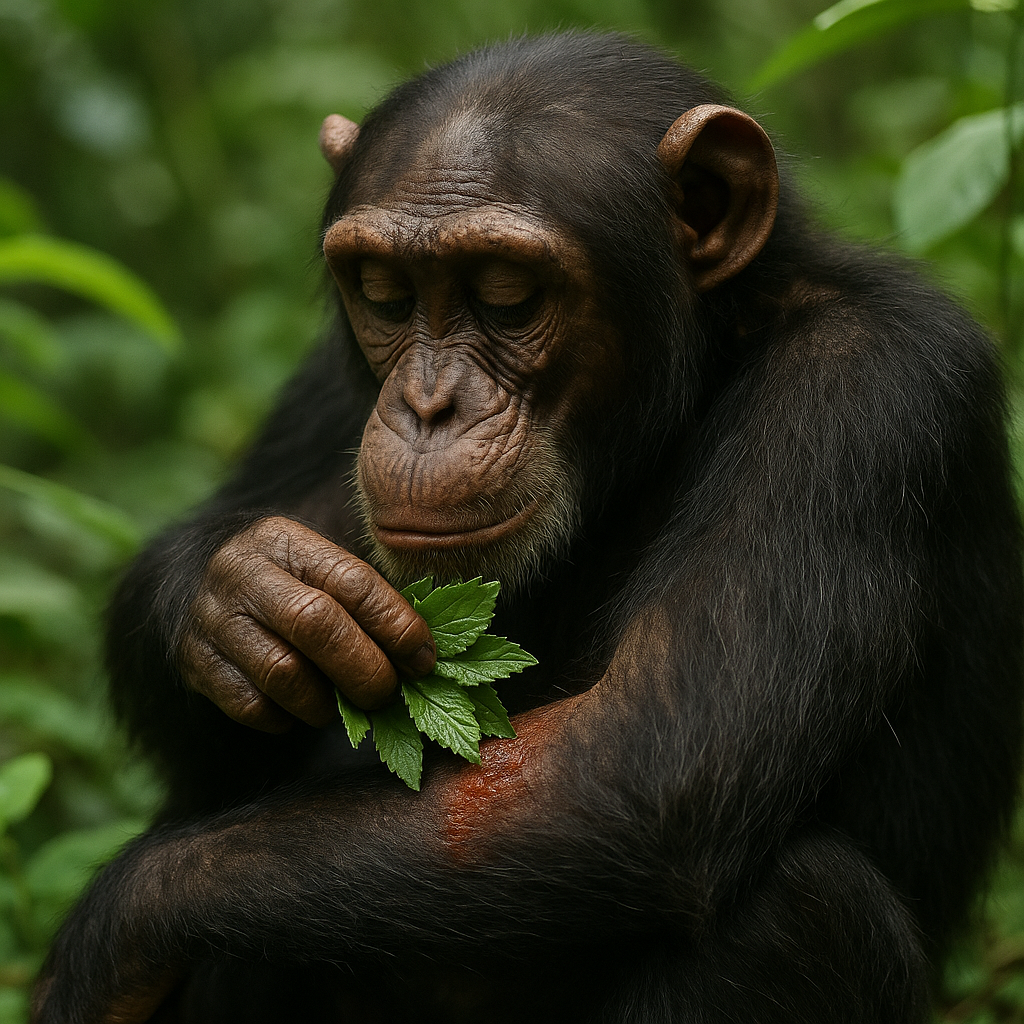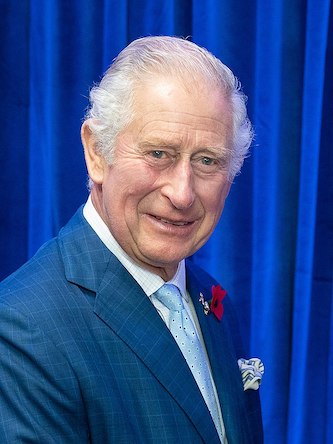In Uganda, wild chimpanzees have been seen using plants to heal their injuries. Scientists from the University of Oxford watched chimpanzees put plants on their cuts and wounds. This shows that chimpanzees know how to use nature to stay healthy. The study was shared in a science journal and helps us learn more about how animals like gorillas and orangutans use natural medicine too.
The lead scientist, Elodie Freymann, said chimpanzees have many ways to care for themselves. They might chew plants or put them on their injuries. One video even showed a young chimp helping her mom with a wound, showing they can be caring. The scientists also looked at stories from the past where chimps used leaves to clean themselves or helped each other with traps.
These findings show that chimpanzees know a lot about their surroundings and which plants can help them heal. Some plants they use have special qualities that fight germs. Learning about this can help us find new medicines. Dr. Freymann said understanding chimpanzees better helps us appreciate how smart they are and how they survive in the wild.
Original news source: Wild chimpanzees filmed using forest ‘first aid’ (BBC)
🎧 Listen:
Slow
Normal
Fast
📖 Vocabulary:
| 1 | chimpanzees | A type of large ape that lives in Africa |
| 2 | injuries | Hurts or damage to the body |
| 3 | scientists | People who study and learn about things in nature |
| 4 | journal | A book or magazine that shares new information |
| 5 | gorillas | Large apes that live in Africa and are very strong |
| 6 | orangutans | Large apes with long arms that live in Asia |
| 7 | medicine | Things that help make you feel better when you’re sick |
| 8 | surroundings | The area around you |
| 9 | qualities | Special features or traits |
| 10 | germs | Tiny creatures that can make you sick |
| 11 | appreciate | To be thankful or understand the value of something |
| 12 | survive | To stay alive, especially in difficult conditions |
Group or Classroom Activities
Warm-up Activities:
– CHARADES
Instructions: Divide the class into small groups. Each group takes turns acting out different actions related to the article, such as “putting a plant on a wound” or “chewing leaves.” The other groups must guess what the action is. This helps students practice vocabulary and engage with the content in a fun way.
– VOCABULARY PICTIONARY
Instructions: Write key vocabulary words from the article (e.g., chimpanzee, heal, plants, injuries) on separate pieces of paper. Students take turns picking a word and drawing it on the board while their classmates guess the word. This activity reinforces vocabulary recognition and usage in a visual way.
– OPINION POLL
Instructions: Ask students if they think animals can use plants to heal themselves. Have them walk around the classroom and ask their classmates for their opinions. After collecting responses, students can share what they found out, allowing them to practice speaking and listening skills while discussing the topic.
– MIND MAP
Instructions: On a large piece of paper or a whiteboard, write “Chimpanzees and Healing” in the center. Students work in pairs to brainstorm and add related ideas, words, or concepts from the article, such as “nature,” “health,” “caring,” and “medicines.” This helps students organize their thoughts and comprehend the main ideas.
– TWO TRUTHS AND A LIE
Instructions: Each student thinks of two true statements and one false statement related to the article’s content about chimpanzees and healing. They share their statements with a partner, who must guess which statement is the lie. This encourages critical thinking and helps reinforce comprehension of the article.
🤔 Comprehension Questions:
1. What did scientists from the University of Oxford watch chimpanzees do with plants?
2. Who is the lead scientist mentioned in the article?
3. How do chimpanzees care for their injuries according to the article?
4. What did one video show a young chimp doing for her mom?
5. Why is it important to learn about how chimpanzees use plants?
6. What special qualities do some plants have that help chimpanzees?
7. How can understanding chimpanzees help us in finding new medicines?
Go to answers ⇩
🎧✍️ Listen and Fill in the Gaps:
In Uganda, wild chimpanzees have been seen (1)______ plants to heal their injuries. Scientists from the (2)______ of Oxford watched chimpanzees put plants on their cuts and wounds. This shows that chimpanzees know how to use nature to stay (3)______. The study was shared in a science journal and helps us learn more about how animals like gorillas and orangutans use natural medicine too.
The lead (4)______, (5)______ Freymann, said (6)______ have many ways to care for themselves. They might chew plants or put them on their injuries. One video even showed a young chimp (7)______ her mom with a wound, showing they can be caring. The scientists also looked at (8)______ from the past where chimps used leaves to clean themselves or helped each (9)______ with traps.
These findings show that chimpanzees know a lot about their surroundings and which plants can (10)______ them heal. Some plants they use have special qualities that fight germs. Learning about this can help us find new medicines. Dr. Freymann (11)______ understanding chimpanzees better helps us appreciate how smart they are and how they (12)______ in the wild.
Go to answers ⇩
💬 Discussion Questions:
Students can ask a partner these questions, or discuss them as a group.
1. What is your favorite animal? Why do you like it?
2. How would you feel if you saw a chimpanzee using a plant to help itself?
3. Do you think animals can understand how to heal themselves? Why or why not?
4. What is a plant that you think is good for health?
5. Have you ever used a plant or medicine to help when you were hurt? What happened?
6. How would you feel if you could talk to animals and learn their secrets?
7. Do you like watching animal videos? Why or why not?
8. What do you think is the smartest animal? Why do you think so?
9. How would you feel if you had to find your own medicine in the wild?
10. Do you think it’s important to learn from animals? Why?
11. What is a way you take care of yourself when you feel sick?
12. How would you feel if you could help an animal that was hurt?
Individual Activities
📖💭 Vocabulary Meanings:
Match each word to its meaning.
Words:
1. chimpanzees
2. injuries
3. scientists
4. journal
5. gorillas
6. orangutans
7. medicine
8. surroundings
9. qualities
10. germs
11. appreciate
12. survive
Meanings:
(A) Hurts or damage to the body
(B) To be thankful or understand the value of something
(C) A type of large ape that lives in Africa
(D) Special features or traits
(E) People who study and learn about things in nature
(F) Tiny creatures that can make you sick
(G) A book or magazine that shares new information
(H) To stay alive, especially in difficult conditions
(I) Large apes with long arms that live in Asia
(J) Things that help make you feel better when you’re sick
(K) Large apes that live in Africa and are very strong
(L) The area around you
Go to answers ⇩
🔡 Multiple Choice Questions:
1. What have chimpanzees in Uganda been seen doing?
(a) Using plants to heal injuries
(b) Climbing trees
(c) Eating fruit
(d) Playing with each other
2. Who watched the chimpanzees using plants?
(a) Tourists in Uganda
(b) Scientists from the University of Oxford
(c) Local farmers
(d) Zoo keepers
3. What did the lead scientist’s name?
(a) Jane Goodall
(b) David Attenborough
(c) Charles Darwin
(d) Elodie Freymann
4. What did one video show a young chimp doing?
(a) Climbing a tree
(b) Helping her mom with a wound
(c) Eating a banana
(d) Playing with friends
5. What do some plants that chimpanzees use fight against?
(a) Germs
(b) Hunger
(c) Cold weather
(d) Other animals
6. Why is learning about chimpanzees important?
(a) It helps us train them better
(b) It shows how to keep them in zoos
(c) It teaches us how to feed them
(d) It can help us find new medicines
7. What do the findings show about chimpanzees?
(a) They only play all day
(b) They do not care for each other
(c) They know a lot about their surroundings
(d) They are afraid of plants
8. How do chimpanzees show they can be caring?
(a) By stealing food from each other
(b) By running away from danger
(c) By helping each other with wounds
(d) By making loud noises
Go to answers ⇩
🕵️ True or False Questions:
1. The chimpanzees ate plants instead of putting them on their cuts and wounds.
2. Chimpanzees can be caring and help each other with wounds.
3. Some plants that chimps use can fight germs.
4. The study was not shared in a science journal.
5. Chimpanzees in Uganda use plants to heal their injuries.
6. Scientists from the University of Cambridge studied these chimpanzees.
7. Elodie Freymann is the lead scientist of the study.
8. Learning about chimpanzees may not necessarily lead to new medicines.
Go to answers ⇩
📝 Write a Summary:
Write a summary of this news article in two sentences.
Check your writing now with the best free AI for English writing!
Writing Questions:
Answer the following questions. Write as much as you can for each answer.
Check your answers with our free English writing assistant!
1. What did scientists from the University of Oxford watch chimpanzees do to heal their injuries?
2. How do chimpanzees show they can care for each other?
3. What special qualities do some plants have that help chimpanzees?
4. Why is it important for us to learn about how chimpanzees use plants?
5. Who is the lead scientist mentioned in the article?
✅ Answers
🤔✅ Comprehension Question Answers:
1. What did scientists from the University of Oxford watch chimpanzees do with plants?
The scientists watched chimpanzees put plants on their cuts and wounds.
2. Who is the lead scientist mentioned in the article?
The lead scientist is Elodie Freymann.
3. How do chimpanzees care for their injuries according to the article?
Chimpanzees care for their injuries by chewing plants or putting them on their wounds.
4. What did one video show a young chimp doing for her mom?
The video showed a young chimp helping her mom with a wound.
5. Why is it important to learn about how chimpanzees use plants?
It is important because it helps us find new medicines and understand how smart chimpanzees are.
6. What special qualities do some plants have that help chimpanzees?
Some plants can fight germs and help chimpanzees heal.
7. How can understanding chimpanzees help us in finding new medicines?
Understanding chimpanzees can show us which plants are good for healing, helping us discover new medicines.
Go back to questions ⇧
🎧✍️✅ Listen and Fill in the Gaps Answers:
(1) using
(2) University
(3) healthy
(4) scientist
(5) Elodie
(6) chimpanzees
(7) helping
(8) stories
(9) other
(10) help
(11) said
(12) survive
Go back to questions ⇧
📖💭✅ Vocabulary Meanings Answers:
1. chimpanzees
Answer: (C) A type of large ape that lives in Africa
2. injuries
Answer: (A) Hurts or damage to the body
3. scientists
Answer: (E) People who study and learn about things in nature
4. journal
Answer: (G) A book or magazine that shares new information
5. gorillas
Answer: (K) Large apes that live in Africa and are very strong
6. orangutans
Answer: (I) Large apes with long arms that live in Asia
7. medicine
Answer: (J) Things that help make you feel better when you’re sick
8. surroundings
Answer: (L) The area around you
9. qualities
Answer: (D) Special features or traits
10. germs
Answer: (F) Tiny creatures that can make you sick
11. appreciate
Answer: (B) To be thankful or understand the value of something
12. survive
Answer: (H) To stay alive, especially in difficult conditions
Go back to questions ⇧
🔡✅ Multiple Choice Answers:
1. What have chimpanzees in Uganda been seen doing?
Answer: (a) Using plants to heal injuries
2. Who watched the chimpanzees using plants?
Answer: (b) Scientists from the University of Oxford
3. What did the lead scientist’s name?
Answer: (d) Elodie Freymann
4. What did one video show a young chimp doing?
Answer: (b) Helping her mom with a wound
5. What do some plants that chimpanzees use fight against?
Answer: (a) Germs
6. Why is learning about chimpanzees important?
Answer: (d) It can help us find new medicines
7. What do the findings show about chimpanzees?
Answer: (c) They know a lot about their surroundings
8. How do chimpanzees show they can be caring?
Answer: (c) By helping each other with wounds
Go back to questions ⇧
🕵️✅ True or False Answers:
1. The chimpanzees ate plants instead of putting them on their cuts and wounds. (Answer: False)
2. Chimpanzees can be caring and help each other with wounds. (Answer: True)
3. Some plants that chimps use can fight germs. (Answer: True)
4. The study was not shared in a science journal. (Answer: False)
5. Chimpanzees in Uganda use plants to heal their injuries. (Answer: True)
6. Scientists from the University of Cambridge studied these chimpanzees. (Answer: False)
7. Elodie Freymann is the lead scientist of the study. (Answer: True)
8. Learning about chimpanzees may not necessarily lead to new medicines. (Answer: False)
Go back to questions ⇧













